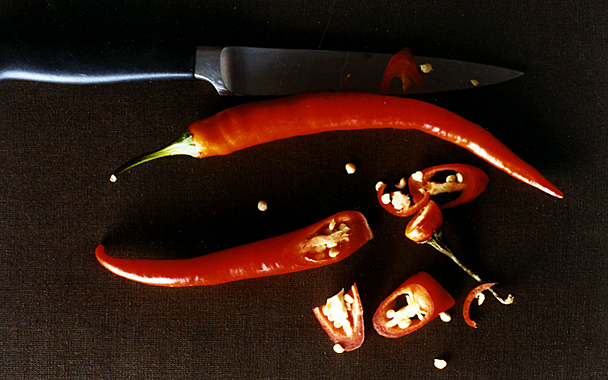I think it’s fair to say that the one sure thing the Gourmet gang has in common is our love for chile peppers, usually the hotter the better. Our takeout lunches from Manhattan’s Grand Sichuan were not complete without an order of blow-out-your-tear-ducts chiles that would sometimes even prompt Ruth Reichl, the ultimate chile lover, to redirect her chopsticks to the luffa to temper the heat. Other times, she wouldn’t even blink—the boss is hardcore.
Smoky red Urfa and fruity cherry-red Maras chiles so bewitched Doc Willoughby that he made a pilgrimage to southern Turkey to eat them. And former food editor Shelley Wiseman incorporates poblanos into her dishes, such as a poblano cream soup, the way other cooks throw in a pinch of salt. Drinks editor and Santa Fe native James Rodewald goes to New Mexico pretty frequently, ostensibly to visit friends and family, but we all know it’s really to eat red or green.
Stephen and I had our fellow chile-heads in mind when it came to choosing our peppers this year. But I had to remember that terroir and climate in the Northeast is not that of Chiang Mai, Thailand, nor of Sanhurfa, Turkey. I may have dreamed of an Urfa chile, but I wasn’t going to get one without booking a flight. That said, there are seemingly a million chile varieties to choose from, and if you grow yours from seed you’ll have even more options. Just make sure you know how long the plants will take to mature—some require 90 days to harvest, which is a challenge in cooler places. Pick an early maturing variety.
We put in fiery jalapeños, habaneros, Hungarian yellow wax, and the Italian heirloom with the blistering name of Baccio deSatana (Satan’s Kiss), along with sweet Italian Pepperoncini and Pizza My Heart, the latter for the ritual Sunday pot of sauce. Peppers can cross-pollinate, so common practice is to grow the hot and sweet varieties at much greater than elbow-to-elbow distance. Community garden plots, though, don’t exactly allow for yawning gaps between plants, so we threw all the peppers together, like some kind of vegetable cocktail mixer. Maybe if we save the seeds from this year’s crop, next year our more demure Italians will show up with Latin American accents. We can only hope.
Being South American in origin, peppers love uniformly moist soil (two inches of water a week), and heat (but below 90 degrees). With the rains that have challenged our tomatoes and eggplant, the peppers seem to be thriving. Which made me think how wonderful the chiles grown in Southeast Asia must be. I checked in with Gourmet’s Asia correspondent, gardener, blogger (at Rambling Spoon), and sometime New Mexico resident Karen Coates to see what I was missing.
“My absolute favorite chile is also the hottest in the world—the Naga chile (or bhut jolokia) from Nagaland and Assam,” Karen says. “But the only peppers I’ve ‘grown’ in Asia were the wild Thai bird’s eye, which did quite well. The seeds were planted by the birds on our back porch, and the largest plant grew into a lovely little tree of chiles. I planted them in New Mexico last year, too, and I thought they were goners but then, toward the end of August, they started coming up with the hottest little peppers.”
Senior Food Editor Alexis Touchet says she’s had great luck with Thai chiles, too, at her home near Woodstock, New York. Okay, ladies, you’re blowing to pieces my point about terroir, prompting me to end this episode with the two words of many a gardener who, midseason, rethinks their options: next year.



 Pinterest
Pinterest


